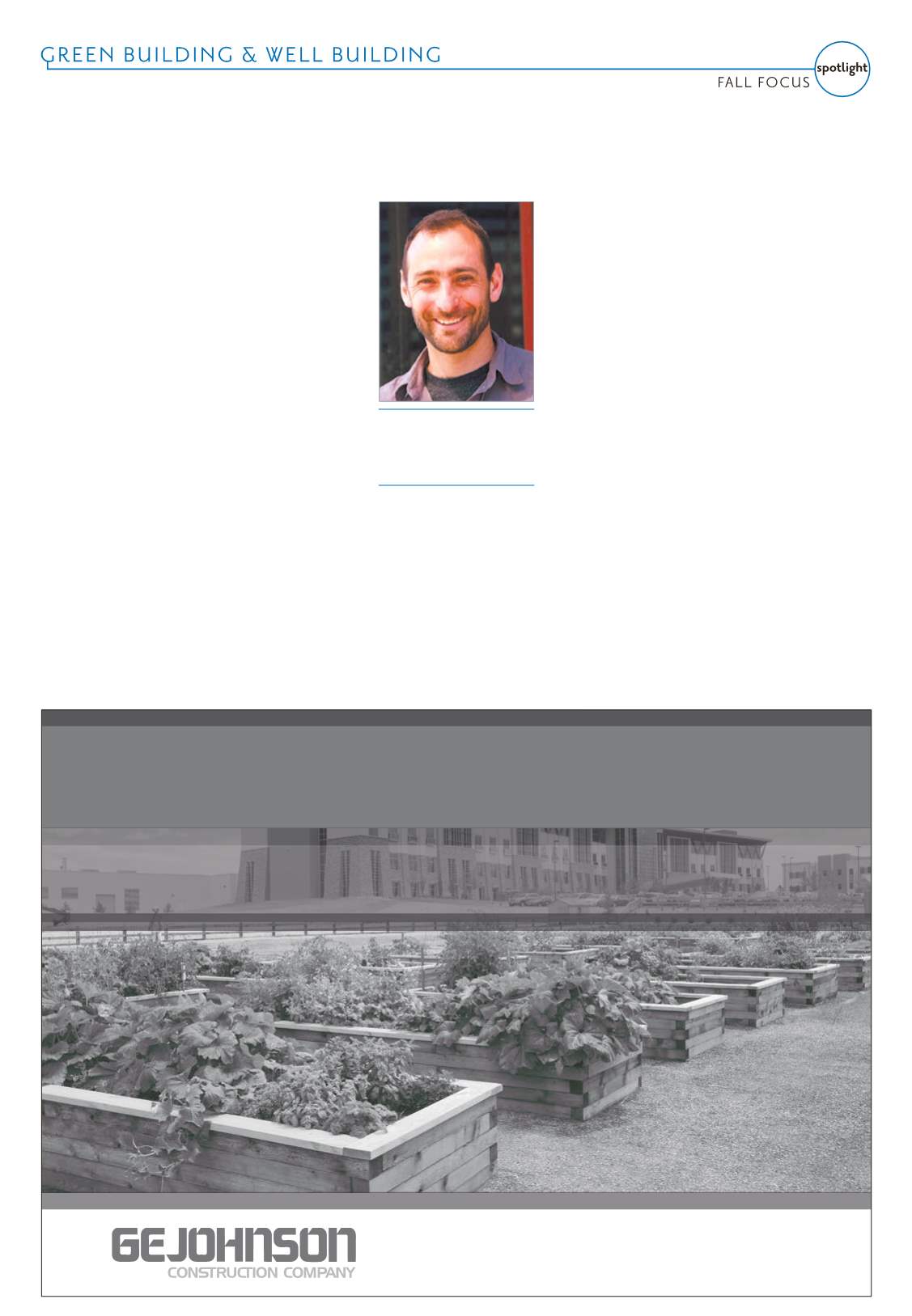
Page 18B—
COLORADO REAL ESTATE JOURNAL
—
September 2-September 15, 2015
Imagine a place that is better than today. It is our responsibility to build sustainably and lay a foundation for the future.
It is our passion to provide ingenuity and reinvent how we build, minimizing the impact on our environment while
bringing communities together.
BUILDING
responsibly for
a bright
FUTURE.
Castle Rock Adventist Health Campus - Community Garden
O
ne of the
most common
frustrations I
hear from the development
community is how stale the
LEED green building rating
system has become, and how
meaningless the pursuit often
feels as a result. And because
there is a perception that
LEED equates to the forward
edge of sustainable buildings,
many have a perception that
sustainability is something
they’ve already figured out –
yesterday’s news. And yet there
is an amazing array of industry-
shaping trends that are raising
the bar in the sustainability
sphere that are worth paying
attention to.
The truth is that LEED really
is woefully behind the times.
Most projects are still using
version 2009, which is the
same year we were upgrading
to an iPhone 2 and watching
President Obama take up
residence in the White House.
In many places around the
U.S. and the world, the LEED
energy standard (ASHRAE
2007) is lower than local
code. Boulder, for example,
references ASHRAE 2010,
and requires a 30 percent
improvement to boot. And
Denver is slated to update its
code to ASHRAE 2013 by the
end of the year. This means
that if you’re working in a lot of
places, including locally, you’re
earning a lot of LEED credits
just by not breaking the law.
Fortunately, nature abhors a
vacuum, and while the decline
(hopefully only temporary) of
LEED has been a setback for
the advance of green building
best practices, which range
from energy, water, climate,
human health and land-use
practices, other standards have
raised the bar and filled in
some of the missing gaps, and
those projects that are working
on these newer standards are
becoming more and more
prevalent. Concepts and
recently emerging certifications
such as Net Zero Energy, Living
Buildings, WELL Buildings,
Sustainable Sites, and even
LEED v4 (available now,
but required for new LEED
registrations in mid-2016) are
all acting as significant drivers
for projects seeking to move
the dial steadily forward on
sustainability.
While just five years ago it
would have been a distant
possibility to work on a project
seeking Net Zero Energy or
seeking to be identified as a
“healthy building or workplace,”
or to use innovative financing
options like a solar power
purchase agreement, now these
themes are becoming more and
more common on projects of
all shapes and sizes. And before
the end of 2015, Colorado is
expected to launch its version
of the Property-Assessed Clean
Energy financing mechanism,
which will make financing
sustainability projects even
more accessible.
One of the main questions we
get is how to make sense of so
many of the emerging trends
and programs, whether a team
is looking for a certification
program to distinguish their
project from the general rabble,
or whether they just want to use
a rating system as a guidepost
for meeting best practices. So
here is a rundown of the top
choices:
n
WELL buildings.
Launched
only last fall, this program
is the best healthy building
certification program out
there, and has gained quick
market share with several
projects in Colorado now
using the standard or pursuing
certification in one form or
another. For a primer on all of
the aspects that go into healthy
buildings, see my recent CREJ
article on the topic. The WELL
Building Standard covers
everything from air quality, to
water quality (when’s the last
time you tested to see what
chemicals were coming out of
your tap?), acoustics, daylight,
food options, mental well-being,
physical activity, etc. Or for
a more general approach to
healthy buildings, check out the
Urban Land Institute’s Building
Healthy Places Toolkit.
n
Living Building Challenge.
While deep into the bleeding
edge, the Living Building
Challenge gives us an ideal
and an aspirational goal to
shoot for. No credits, no
well-meaning design intent;
just mandatory performance
requirements. LBC buildings
are all about the absolute:
Net Zero Energy, Net Zero
Water, Net Zero Stormwater;
all occupants must have access
to daylight, operable windows
and all materials should be free
of chemicals that are harmful
to the inhabitants or that are
released in the production or
disposal.
n
Net Zero Energy.
If the
full Living Building Challenge
is too much to bite off, many
projects opt only for Net Zero
Energy certification, which
basically involves demonstrating
that your project uses only the
energy it collects from onsite
renewable energy sources.
n
Sustainable Sites Initiative.
If you have a significant site and
are looking to manage it so that
it creates usable outdoor areas,
uses landscape and natural
systems to manage stormwater,
creates habitat, grows food,
and improves acoustics and air
quality, then this is the rating
system for you. Especially for
master-plan projects, where
LEED-ND feels flat, SSI has a
lot to include as best land-use
practices.
n
LEED v4.
If LEED has
a hope for resurrection and
regaining its past momentum,
it lies within LEED v4., available
for use now, but not required
for new projects until mid-
Josh Radoff,
LEED AP BD+C
Principal and co-founder,
YR&G, Denver


